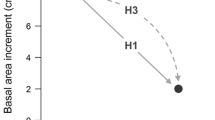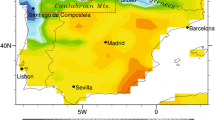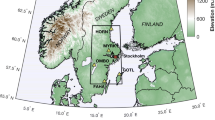Abstract
Recent analyses on the length of drought recovery in forests have shown multi-year legacies, particularly in semi-arid, coniferous ecosystems. Such legacies are usually attributed to ecophysiological memory, although drought frequency itself, and its effect on overlapping recovery times, could also contribute. Here, we describe a multi-decadal study of drought legacies using tree-ring carbon-isotope ratios (δ13C) and ring-width index (RWI) in Pinus ponderosa at 13 montane sites traversing a winter–summer precipitation gradient in the Southwestern U.S. Sites and trees were selected to avoid collection biases that exist in archived tree-ring databanks. The spatial hydroclimate gradient and winter–summer seasonal patterns were well predicted by seasonal and inter-annual correlations between δ13C and atmospheric vapor pressure deficit (VPD). Using VPD, we found that the probability of extreme drought has increased up to 70% in this region during the past two decades. When the recent increase in drought frequency was not considered, multi-year legacies in both δ13C and RWI were observed at most sites. When the increase in drought frequency was detrended from tree-ring chronologies, some sites exhibited short legacies (1–2 years) in both δ13C and RWI, and there was a sight trend for longer legacies in RWI. However, when considered broadly across the region and multiple decades, no significant legacies were observed, which contrasts with past studies. Our results reveal that a contribution to observed multi-year legacies is related to shifts in the climate system itself, an exogenous factor, that must be considered along with physiological memory.






Similar content being viewed by others
Data accessibility
All data for this manuscript will be posted in the International Tree-Ring Database (ITRDB).
References
Adams HD, Zeppel MJB, Anderegg WRL et al (2017) A multi-species synthesis of physiological mechanisms in drought-induced tree mortality. Nat Ecol Evol 1:1285–1291. https://doi.org/10.1038/s41559-017-0248-x
Allen CD, Breshears DD, McDowell NG (2015) On underestimation of global vulnerability to tree mortality and forest die-off from hotter drought in the Anthropocene. Ecosphere. https://doi.org/10.1890/es15-00203.1
Anderegg WRL, Schwalm CR, Biondi F et al (2015) Pervasive drought legacies in forest ecosystems and their implications for carbon cycle models. Science 349:528–532. https://doi.org/10.1126/science.aab1833
Ault TR, Mankin JS, Cook BI, Smerdon JE (2016) Relative impacts of mitigation, temperature, and precipitation on 21st-Century megadrought risk in the American Southwest. Sci Adv 2:1–9. https://doi.org/10.1126/sciadv.1600873
Babst F, Alexander MR, Szejner P et al (2014) A tree-ring perspective on the terrestrial carbon cycle. Oecologia 176:307–322. https://doi.org/10.1007/s00442-014-3031-6
Barron-Gafford GA, Cable JM, Bentley LP et al (2014) Quantifying the timescales over which exogenous and endogenous conditions affect soil respiration. New Phytol 202:442–454. https://doi.org/10.1111/nph.12675
Beardsell MF, Cohen D (1975) Relationships between leaf water status, abscisic acid levels and stomatal resistance in maize and sorghum. Plant Physiol 56:207–212. https://doi.org/10.1104/pp.56.2.207
Biederman JA, Scott RL, Bell TW et al (2017) CO2 exchange and evapotranspiration across dryland ecosystems of southwestern North America. Global Change Biol 23:4204–4221. https://doi.org/10.1111/gcb.13686
Bierhuizen JF, Slatyer RO (1965) Effect of atmospheric concentration of water vapour and CO2 in determining transpiration photosynthesis relationships of cotton leaves. Agric Meteorol 2:259–270. https://doi.org/10.1016/0002-1571(65)90012-9
Breshears DD, Cobb NS, Rich PM et al (2005) Regional vegetation die-off in response to global-change-type drought. Proc Natl Acad Sci USA 102:15144–15148. https://doi.org/10.1073/pnas.0505734102
Brodribb TJ, McAdam SA (2013) Abscisic acid mediates a divergence in the drought response of two conifers. Plant Physiol 162:1370–1377. https://doi.org/10.1104/pp.113.217877
Bunn AG (2008) A dendrochronology program library in R (dplR). Dendrochronologia 26:115–124. https://doi.org/10.1016/j.dendro.2008.01.002
Chree C (1913) Some phenomena of sunspots and of terrestrial magnetism at Kew Observatory. Phil Trans R Soc A Math Phys Eng Sci 212:75–116. https://doi.org/10.1098/rsta.1913.0003
Cook ER, Peters K (1997) Calculating unbiased tree-ring indices for the study of climatic and environmental change. Holocene 7:361–370. https://doi.org/10.1177/095968369700700314
Cook BI, Seager R (2013) The response of the North American Monsoon to increased greenhouse gas forcing. J Geophys Res Atmos 118:1690–1699. https://doi.org/10.1002/jgrd.50111
Cook BI, Ault TR, Smerdon JE (2015) Unprecedented 21st Century drought risk in the American Southwest and Central Plains. Science Advances. https://doi.org/10.1126/sciadv.1400082
Dai A (2013) Increasing drought under global warming in observations and models. Nat Clim Change 3:52–58. https://doi.org/10.1038/nclimate1633
Dai A, Trenberth KE, Qian T (2004) A global dataset of Palmer Drought Severity Index for 1870–2002: relationship with soil moisture and effects of surface warming. J Hydrometeorol 5:1117–1130. https://doi.org/10.1175/JHM-386.1
Dorado-Liñán I, Piovesan G, Martínez-Sancho E et al (2019) Geographical adaptation prevails over species-specific determinism in trees’ vulnerability to climate change at Mediterranean rear-edge forests. Global Change Biol 25:1296–1314. https://doi.org/10.1111/gcb.14544
Engeland K, Hisdal H, Frigessi A (2005) Practical extreme value modelling of hydrological floods and droughts: a case study. Extremes 7:5–30. https://doi.org/10.1007/s10687-004-4727-5
Farrior CE, Dybzinski R, Levin SA, Pacala SW (2013) Competition for water and light in closed-canopy forests: a tractable model of carbon allocation with implications for carbon sinks. Am Nat 181:314–330. https://doi.org/10.1086/669153
Ficklin DL, Novick KA (2017) Historic and projected changes in vapor pressure deficit suggest a continental-scale drying of the United States atmosphere. J Geophys Res Atmos 122:2061–2079. https://doi.org/10.1002/2016JD025855
Francey R, Farquhar G (1982) An explanation of 13C/12C variations in tree rings. Nature 297:28–31. https://doi.org/10.1038/297028a0
Griffin D, Meko DM, Touchan R et al (2011) Latewood chronology development for summer-moisture reconstruction in the US Southwest. Tree-Ring Res 67:87–101. https://doi.org/10.3959/2011-4.1
Hacke UG, Stiller V, Sperry JS et al (2001) Cavitation fatigue. Embolism and refilling cycles can weaken the cavitation resistance of xylem. Plant Physiol 125:779–786. https://doi.org/10.1104/pp.125.2.779
Hall AE, Kaufmann M (1975) Stomatal response to environment with Sesamum indicum L. Plant Physiol 55:455–459. https://doi.org/10.1104/pp.55.3.455
Hammond WM, Yu K, Wilson LA, Will RE, Anderegg WRL, Adams HD (2019) Dead or dying? Quantifying the point of no return from hydraulic failure in drought-induced tree mortality. New Phytol. https://doi.org/10.1111/nph.15922
Hartmann H, Moura C, Anderegg W, Ruehr N, Salmon Y, Allen CD, Arndt SK, Breshears DD, Davi H, Galbraith D, Ruthrof KX, Wunder J, Adams HD, Bloemen J, Cailleret M, Cobb R, Gessler A, Grams TEE, Jansen S, Kautz M, Lloret F, O’Brien M (2018) Research frontiers for improving our understanding of drought-induced tree and forest mortality. New Phytol. https://doi.org/10.1111/nph.15048
Haurwitz M, Brier G (1981) A critique of the superposed epoch analysis method—its application to solar weather relations. Mon Weather Rev 109:2074–2079. https://doi.org/10.1175/1520-0493
Huang M, Wang X, Keenan TF, Piao S (2018) Drought timing influences the legacy of tree growth recovery. Global Change Biology 24(8):3546–3559. https://doi.org/10.1111/gcb.14294
Huntington TG (2006) Evidence for intensification of the global water cycle: review and synthesis. J Hydrol 319:83–95. https://doi.org/10.1016/j.jhydrol.2005.07.003
Kannenberg SA, Maxwell JT, Pederson N, D’Orangeville L, Ficklin DL, Phillips RP (2019a) Drought legacies are dependent on water table depth, wood anatomy and drought timing across the eastern US. Ecol Lett 22:119–127. https://doi.org/10.1111/ele.13173
Kannenberg SA, Novick KA, Alexander MR, Maxwell JT, Moore DJP, Phillips RP, Anderegg WRL (2019b) Linking drought legacy effects across scales: from leaves to tree rings to ecosystems. Global Change Biol 25:2978–2992. https://doi.org/10.1111/gcb.14710
Klesse S, De Rose RJ, Guiterman CH, Lynch AM, O’Connor CD, Shaw JD, Evans MEK (2018) Sampling bias overestimates climate change impacts on forest growth in the southwestern United States. Nat Commun 9(1):5336. https://doi.org/10.1038/s41467-018-07800-y
Kolus HR, Huntzinger DN, Schwalm CR et al (2019) Land carbon models underestimate the severity and duration of drought’s impact on plant productivity. Sci Rep. https://doi.org/10.1038/s41598-019-39373-1
Kozlowski TT, Pallardy SG, Kramer PJ (1991) The physiological ecology of woody plants. Academic Press, San Diego. https://doi.org/10.1016/C2009-0-02706-8
Leavitt SW, Danzer SR (1993) Method for batch processing small wood samples to holocellulose for stable-carbon isotope analysis. Anal Chem 65:87–89. https://doi.org/10.1021/ac00049a017
Lloret F, Keeling EG, Sala A (2011) Components of tree resilience: effects of successive low-growth episodes in old ponderosa pine forests. Oikos 120:1909–1920. https://doi.org/10.1111/j.1600-0706.2011.19372.x
Martins SCV, McAdam SAM, Deans RM, DaMatta FM, Brodribb TJ (2016) Stomatal dynamics are limited by leaf hydraulics in ferns and conifers: results from simultaneous measurements of liquid and vapour fluxes in leaves. Plant Cell Environ 39:694–705. https://doi.org/10.1111/pce.12668
McAdam SAM, Brodribb TJ (2014) Separating active and passive influences on stomatal control of transpiration. Plant Physiol 164:1578–1586. https://doi.org/10.1104/pp.113.231944
McCarroll D, Gagen MH, Loader NJ et al (2009) Correction of tree ring stable carbon isotope chronologies for changes in the carbon dioxide content of the atmosphere. Geochim Cosmochim Acta 73:1539–1547. https://doi.org/10.1016/j.gca.2008.11.041
McDowell NG (2011) Mechanisms linking drought, hydraulics, carbon metabolism, and vegetation mortality. Plant Physiol 155:1051–1059. https://doi.org/10.1104/pp.110.170704
McDowell NG, Allen CD (2015) Darcy’s law predicts widespread forest mortality under climate warming. Nature Clim Change 5:669–672. https://doi.org/10.1038/nclimate2641
McDowell NG, Allen CD, Marshall L (2010) Growth, carbon-isotope discrimination, and drought-associated mortality across a Pinus ponderosa elevational transect. Global Change Biol 16:399–415. https://doi.org/10.1111/j.1365-2486.2009.01994.x
McDowell NG, Williams AP, Xu C et al (2015) Multi-scale predictions of massive conifer mortality due to chronic temperature rise. Nat Clim Change 6:295–300. https://doi.org/10.1038/nclimate2873
Meko DM, Baisan CH (2001) Pilot study of latewood-width of conifers as an indicator of variability of summer rainfall in the North American monsoon region. Int J Climatol 21:697–708. https://doi.org/10.1002/joc.646
Mekonnen ZA, Grant RF, Schwalm C (2017) Carbon sources and sinks of North America as affected by major drought events during the past 30 years. Agric For Meteorol 244–45:42–56. https://doi.org/10.1016/j.agrformet.2017.05.006
Mudelsee M, Borngen M, Tetzlaff G, Grunewald U (2003) No upward trends in the occurrence of extreme floods in central Europe. Nature 425:166–169. https://doi.org/10.1038/nature01928
Mudelsee M, Börngen M, Tetzlaff G, Grünewald U (2004) Extreme floods in central Europe over the past 500 years: role of cyclone pathway “Zugstrasse Vb”. J Geophys Res Atmos 109:1–21. https://doi.org/10.1029/2004JD005034
Mueller RC, Scudder CM, Porter ME et al (2005) Differential tree mortality in response to severe drought: evidence for long-term vegetation shifts. J Ecol 93:1085–1093. https://doi.org/10.1111/j.1365-2745.2005.01042.x
Neves DM, Almeida LADH, Santana-Vieira DDS et al (2017) Recurrent water deficit causes epigenetic and hormonal changes in citrus plants. Sci Rep. https://doi.org/10.1038/s41598-017-14161-x
Novick KA, Ficklin DL, Stoy PC et al (2016) The increasing importance of atmospheric demand for ecosystem water and carbon fluxes. Nat Clim Change 6:1023–1027. https://doi.org/10.1038/NCLIMATE311
Nowacki GJ, Abrams MD, Building F (1997) Radial-growth averaging criteria for reconstructing disturbance histories from presettlement-origin oaks. Ecol Monogr 67(2):225–249
Ogle K, Whitham TG, Cobb NS (2000) Tree-ring variation in pinyon predicts likelihood of death following severe drought. Ecology 81:3237–3243. https://doi.org/10.1890/0012-9658
Ogle K, Barber JJ, Barron-Gafford GA et al (2015) Quantifying ecological memory in plant and ecosystem processes. Ecol Lett 18:221–235. https://doi.org/10.1111/ele.12399
Pascale S, Boos WR, Bordoni S et al (2017) Weakening of the North American monsoon with global warming. Nat Clim Change 7:1–8. https://doi.org/10.1038/nclimate3412
Pedersen BS (1998) The role of stress in the mortality of Midwestern oaks as indicated by growth prior to death. Ecology 79:79–93. https://doi.org/10.1890/0012-9658
Peltier DMP, Ogle K (2019a) Legacies of La Niña: North American monsoon can rescue trees from winter drought. Global Change Biol 25:121–133. https://doi.org/10.1111/gcb.14487
Peltier DMP, Ogle K (2019b) Legacies of more frequent drought in ponderosa pine across the western United States. Glob Change Biol. https://doi.org/10.1111/gcb.14720
Peltier DMP, Fell M, Ogle K (2016) Legacy effects of drought in the southwestern United States: a multi-species synthesis. Ecol Monogr 86:312–326. https://doi.org/10.1002/ecm.1219/suppinfo
Peltier DMP, Barber J, Ogle K (2017) Quantifying antecedent climatic drivers of tree growth in the Southwestern US. J Ecol 12:3218–3221. https://doi.org/10.1111/1365-2745.12878
Pettitt AN (1979) A non-parametric approach to the change-point problem. J R Stat Soc Series C (App Stat) 28:126–135. https://doi.org/10.2307/2346729
Poulter B, Frank D, Ciais P et al (2014) Contribution of semi-arid ecosystems to interannual variability of the global carbon cycle. Nature 509:600–603. https://doi.org/10.1038/nature13376
Powell TL, Galbraith DR, Christoffersen BO et al (2013) Confronting model predictions of carbon fluxes with measurements of Amazon forests subjected to experimental drought. New Phytol 200:350–365. https://doi.org/10.1111/nph.12390
Prein AF, Holland GJ, Rasmussen RM et al (2016) Running dry: the U.S. Southwest’s drift into a drier climate state. Geophys Res Lett 43:1272–1279. https://doi.org/10.1002/2015GL066727
PRISM Climate Group (2004) Oregon State University. In: PRISM. http://prism.oregonstate.edu
Pugh TAM, Lindeskog M, Smith B et al (2019) The role of forest regrowth in global carbon sink dynamics. Proc Natl Acad Sci 116:1–6. https://doi.org/10.1073/pnas.1810512116
Reichstein M, Bahn M, Ciais P et al (2013) Climate extremes and the carbon cycle. Nature 500:287–295. https://doi.org/10.1038/nature12350
Schönbeck L, Gessler A, Hoch G et al (2018) Homeostatic levels of nonstructural carbohydrates after 13 year of drought and irrigation in Pinus sylvestris. New Phytol 219:1314–1324. https://doi.org/10.1111/nph.15224
Schulze E-D, Lange OL, Evenari M, Kappen L, Buschbom U (1975) Role of air humidity and temperature in controlling stomatal resistance of Prunus armenica L. under desert conditions. 3. Effect on water use efficiency. Oecologia 19:303–314. https://doi.org/10.1007/BF00348106
Schwalm CR, Anderegg WRL, Michalak AM et al (2017) Global patterns of drought recovery. Nature 548:202–205. https://doi.org/10.1038/nature23021
Seager R, Ting M, Li C et al (2013) Projections of declining surface-water availability for the southwestern United States. Nat Clim Change 3:482–486. https://doi.org/10.1038/nclimate1787
Serra-Maluquer X, Mencuccini M, Martínez-Vilalta J (2018) Changes in tree resistance, recovery and resilience across three successive extreme droughts in the northeast Iberian Peninsula. Oecologia 187:343–354. https://doi.org/10.1007/s00442-018-4118-2
Sevanto S, Mcdowell NG, Dickman LT, Pangle R, Pockman WT (2014) How do trees die? A test of the hydraulic failure and carbon starvation hypotheses. Plant Cell Environ 37(1):153–161. https://doi.org/10.1111/pce.12141
Sheffield J, Wood EF, Roderick ML (2012) Little change in global drought over the past 60 years. Nature 491:435–438. https://doi.org/10.1038/nature11575
Skelton RP, Brodribb TJ, McAdam SAM, Mitchell PJ (2017) Gas exchange recovery following natural drought is rapid unless limited by loss of leaf hydraulic conductance: evidence from an evergreen woodland. New Phytol 215:1399–1412. https://doi.org/10.1111/nph.14652
Stahle DW, Cleaveland MK, Grissino-Mayer HD et al (2009) Cool- and warm-season precipitation reconstructions over western New Mexico. J Clim 22:3729–3750. https://doi.org/10.1175/2008JCLI2752.1
Stark SC, Breshears DD, Garcia ES et al (2016) Toward accounting for ecoclimate teleconnections: intra- and inter-continental consequences of altered energy balance after vegetation change. Landsc Ecol 31:181–194. https://doi.org/10.1007/s10980-015-0282-5
Stokes MA, Smiley TL (1996) An introduction to tree-ring dating. The University of Arizona Press, Tucson, Arizona, USA. ISBN-10: 0816516804
Suess HE (1955) Radiocarbon concentration in modern wood. Science 122:415–417. https://doi.org/10.1126/science.122.3166.415-a
Szejner P, Wright WE, Babst F et al (2016) Latitudinal gradients in tree ring stable carbon and oxygen isotopes reveal differential climate influences of the North American Monsoon System. J Geophys Res Biogeosci 121:1978–1991. https://doi.org/10.1002/2016JG003460
Szejner P, Wright WE, Belmecheri S et al (2018) Disentangling seasonal and interannual legacies from inferred patterns of forest water and carbon cycling using tree-ring stable isotopes. Global Change Biol 24:5332–5347. https://doi.org/10.1111/gcb.14395
Timofeeva G, Treydte K, Bugmann H et al (2017) Long-term effects of drought on tree-ring growth and carbon isotope variability in Scots pine in a dry environment. Tree Physiol 37:1028–1041. https://doi.org/10.1093/treephys/tpx041
Touchan R, Woodhouse CA, Meko DM, Allen C (2011) Millennial precipitation reconstruction for the Jemez Mountains, New Mexico, reveals changing drought signal. Int J Climatol 31:896–906. https://doi.org/10.1002/joc.2117
Touma D, Ashfaq M, Nayak MA et al (2015) A multi-model and multi-index evaluation of drought characteristics in the 21st century. J Hydrol 526:196–207. https://doi.org/10.1016/j.jhydrol.2014.12.011
Trenberth KE, Dai A, van der Schrier G et al (2014) Global warming and changes in drought. Nat Clim Change 4:17–22. https://doi.org/10.1038/NCLIMATE2067
Udall C, Overpeck J (2017) The twenty-first century Colorado River hot drought and implications for the future. Water Resour Res 53:2404–2418. https://doi.org/10.1002/2016WR019638
Williams PA, Allen CD, Macalady AK et al (2013) Temperature as a potent driver of regional forest drought stress and tree mortality. Nat Clim Change 3:292–297. https://doi.org/10.1038/nclimate1693
Wu X, Liu H, Li X, Ciais P, Babst F, Guo W, Zhang C, Magliulo V, Pavelka M, Liu S, Huang Y, Wang P, Shi C, Ma Y (2017) Differentiating drought legacy effects on vegetation growth over the temperate Northern Hemisphere. Glob Change Biol. https://doi.org/10.1111/gcb.13920
Yan W, Zheng S, Zhong Y, Shangguan Z (2017) Contrasting dynamics of leaf potential and gas exchange during progressive drought cycles and recovery in Amorpha fruticosa and Robinia pseudoacacia. Sci Rep. https://doi.org/10.1038/s41598-017-04760-z
Yuan W, Zheng Y, Piao S, Ciais P, Lombardozzi D, Wang Y, Ryu Y et al (2019) Increased atmospheric vapor pressure deficit reduces global vegetation growth. Sci Adv. https://doi.org/10.1126/sciadv.aax1396
Zabadal TJ (1974) A water potential threshold for the increase of abscisic acid in leaves. Plant Physiol 53:125–127. https://doi.org/10.1104/pp.53.1.125
Acknowledgements
This study was supported by a grant from the Macrosystems Program in the Emerging Frontiers Section of the U.S. National Science Foundation (NSF Award 1065790), the Ecosystems Program in the Division of Environmental Biology (NSF Award 1754430), and the Inter-University Training Program in Continental-scale Ecology (NSF Award 1137336). We thank Elisabeth Bergman, Miles Twitty, Fred Moreno, Leon Prescott Wells, Monica Vogel, Megan Mckey, Grace Kim, Alyssa Langford Abbey, and Seth Stephens for their technical assistance. Valuable discussions were provided by Valerie Trouet, Steve Leavitt, Ed Wright and Dave Meko from the Laboratory of Tree-Ring Research at the University of Arizona. The tree-ring data and isotope chronologies will be archived in the International Tree-Ring Databank or will be made available upon request to Paul Szejner (paulszejner@email.arizona.edu).
Author information
Authors and Affiliations
Contributions
PS and RKM conceived the ideas and designed methodology; PS, SB, and JRE collected the data; PS, SB, JRE and RKM analyzed the data; PS and RKM led the writing of the manuscript; PS, SB, JRE and RKM contributed critically to the drafts and gave final approval for publication.
Corresponding author
Additional information
Communicated by Arthur Gessler.
Electronic supplementary material
Below is the link to the electronic supplementary material.
Rights and permissions
About this article
Cite this article
Szejner, P., Belmecheri, S., Ehleringer, J.R. et al. Recent increases in drought frequency cause observed multi-year drought legacies in the tree rings of semi-arid forests. Oecologia 192, 241–259 (2020). https://doi.org/10.1007/s00442-019-04550-6
Received:
Accepted:
Published:
Issue Date:
DOI: https://doi.org/10.1007/s00442-019-04550-6




